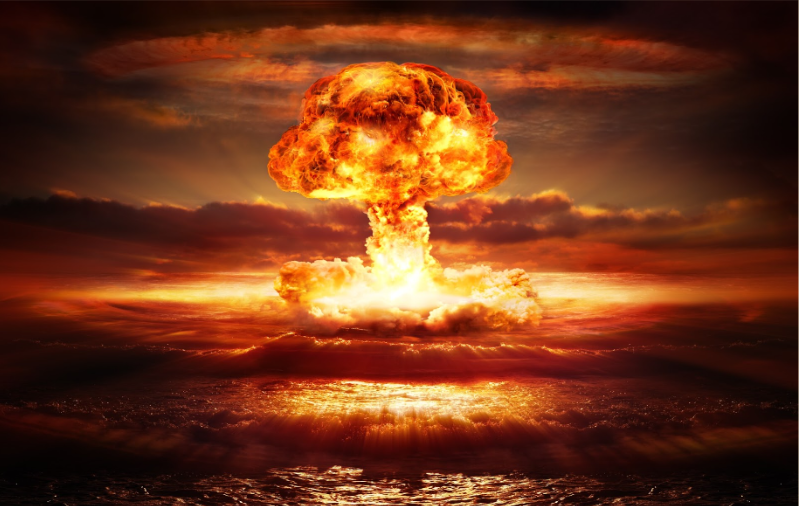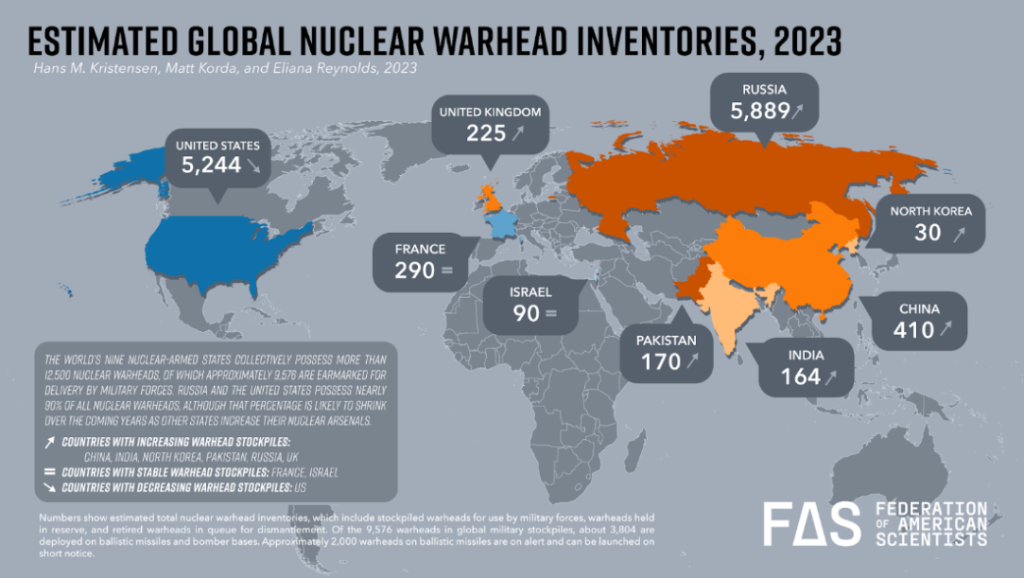INTRODUCTION-
Nuclear Proliferation refers to the acquisition of nuclear weapons by countries and their increasing manufacture globally. It can be compared to the arms race earlier during the 20th Century. Nuclear Proliferation can be noted as a marked illustration of increasing globalization. The era of advancing control on nuclear energy began in 1945 when the United States of America dropped two bombs on the cities of Hiroshima and Nagasaki in Japan under the Manhattan Project.
While the Second World War was ending, this event shocked the entire world. The effects of this attack were not just devastating but also crippled these two cities for generations thereafter. Further, the categorization of weapons into further kinds- atomic, biological, and chemical weapons made the issue more complex.
Nuclear energy, through the process of nuclear fission and fusion, is used to manufacture atom bombs. Evolving technology and an increased appetite for maintaining global hegemony have resorted nations to getting into this arms race. United Nations Commission for Conventional Armaments 1948 introduced a new category of Weapons of mass destruction to distinguish nuclear weapons from traditional ones.
NUCLEAR PROLIFERATION-
This race for acquiring nuclear weapons can be divided into two ages roughly. They are as follows-
- FIRST NUCLEAR AGE( 1945-1990)-
The first nuclear age can be roughly denoted as the time between 1945-1990. It started with the United States of America blasting its atom bombs in 1944 in Japan. This followed the rise of the USA as a global power on the world platform, establishing US hegemony worldwide. Owing to the alarming rise of the USA, the Soviet Union of Russia felt threatened and soon became a nuclear state in 1949. This was followed by the acquisition by the United Kingdom in 1952, France in 1960, and China in 1962. These nations were the ‘powerful five’ or the original nation-states to acquire them. These nations later strived to make the world a nuclear-free space which came across as quite ironic.
In 1967, Outer Space Treaty was signed to prohibit the use of any weapon of mass destruction in space or any other celestial body. In 1968, Nuclear Non-Proliferation Treaty was signed with 191 member states today to prevent the spread of nuclear weapons and further the peaceful uses of nuclear weapons. India is not a member state along with North Korea, Israel, and South Sudan. Pakistan signed but later withdrew from the Treaty. In 1972 further, Strategic Arms Limitation Treaty( SALT) was signed between USA and USSR to stop the usage of inter-continental ballistic missiles.
- SECOND NUCLEAR AGE(1990- present )-
This Second Nuclear Age distinctively started with the acquisition of nuclear weapons by third-world countries among others. Countries that were long colonized began to establish themselves in the New World Order. India and Pakistan had become nuclear states just before 1990. North Korea developed its nuclear weapons by 2006 and Iran was in the news quite recently in 2020. However, a major problem that arose with the Second Nuclear Age was how some states continued to function opaquely which made it significantly tough to track their nuclear developments.
Although a significant feature of the Second Nuclear Age was that the hostility between USA and USSR broke down and this led to international cooperation with a focus on economic development and social issues.
A major significant event was the hanging of Saddam Hussain in 2006. The USA alleged that Iraq had control of weapons of mass destruction among other reasons and organized pre-emptive strikes in Iraq in 2003. However, enough evidence regarding the same wasn’t found.
Then, the Joint Comprehensive Plan of Action was signed between USA and Iran following the lifting of economic sanctions by the USA over Iran but the latter had to restrict the manufacture of nuclear weapons–based raw materials leading to further controversies in 2020. With the most recent threats of Russia to Ukraine to use these weapons against them, the issue of nuclear weapons is extremely concerning.
WHAT MOTIVATES STATES TO BECOME NUCLEAR STATES?
The initial use of nuclear weapons by the USA on Japan was to weaken Japan. Nation-states fighting wars or engaged in tensions do so to weaken the other state or perhaps threaten them. The impact of weapons of mass destruction is massive which assists states in warding off their enemies from a position of power and strength. Acquisition of nuclear weapons makes them come off as powerful on the global platform making them a world hegemon.
Another significant use as stated by most nuclear states is the maximization of national security, that is securing the territorial boundaries of one’s state and maintaining the balance of power within the region.
ANTI-PROLIFERATION EFFORTS-
- NPT (Non-proliferation Treaty)- 1968- It is one of the most significant treaties of all times which came into existence in 1968 and came into force in 1970. The Treaty divide the states into two categories- those possessing nuclear bombs before 1st January 1967 and those who did not. It binds the non-nuclear states into not becoming nuclear states with allowance for peaceful usage of nuclear energy. These safeguards are however not binding on the weapon states which are free to use nuclear energy and expand their capabilities.
- SALT(Strategic Arms Reduction Talks)- 1972- It was a bilateral Treaty between the USA and USSR. This agreement sets limits on the number of strategic ballistic launchers of the US and USSR for five years pending a comprehensive agreement. The agreement set the target for the reduction of ICBM and SLBM. The agreement was further extended to another 5 years.
- START( Strategic Arms Reduction Treaty) Agreements- 1991 was signed for the reduction and limitation of strategic offensive arms including nuclear arms. This was followed by START 2 in 1993.
- INF( Intermediate-Range Nuclear Forces Treaty)- 1997- It was signed to limit the deployments and use of intermediate and shorter-range carrying nuclear weapons. This applied to all Soviet and American missiles installed in Asia and Europe.
- CTBT( Comprehensive Test Ban Treaty) +- 1996- This is a multilateral Treaty under the United Nations that bans all nuclear tests, for both civilian and military purposes in all environments.
CONCLUSION-
After the end of the Cold War global politics changed, and with these changes new major issues emerged. At present time we need to address the issue of non-proliferation with modern means. We also need to look at this matter in the context of rising environmental challenges. In the coming decades, the issues related to the proliferation of nuclear weapons may change. Even today, it is needed that the leaders of the world look towards peace and try to avoid conflicts.
MUST READ: BIBLIOTHERAPY: A LESSER-KNOWN CONCEPT
-Bhawini Srivastava



